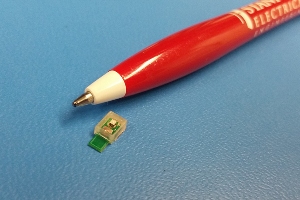Researchers at Stanford University have developed an ultrasound-powered, tiny electronic device for medical implant applications. These devices can be powered wirelessly, and now the researchers are trying to further reduce its size.
 Arbabian Lab / Stanford School of Engineering
Arbabian Lab / Stanford School of Engineering
Tiny electronic devices implanted in the body can help monitor the processes happening in the body, and also deliver therapy to specific locations for targeted treatment with minimal side effects. However, the devices developed previously are not small enough to be fully implanted, and also require batteries or wires for delivering power.
The researchers are developing safe, wireless methods to send power to smart chips on the device that have been programmed to carry out medical tasks and then send back the results. Ultrasound waves are beamed at a device implanted in the body, which transforms these waves into electricity, which then provides power for the device to perform medical tasks. The report is then sent out through a built-in radio antenna.
Ultrasound is already being used for many medical applications, including fetal imaging. It has the capability to power implants that are less than a millimeter in size.
The implant is designed to be powered by piezoelectricity - where vibrations are converted into a small electrical current. The ultrasound triggered vibrations in a small piece of piezoelectric material attached to the implant, which created enough electricity to power it.
A functioning prototype of this wireless medical implant system was presented at the IEEE Custom Integrated Circuits Conference. This prototype measures about the size of a ballpoint pen’s head. The researchers are now attempting to design a smart chip medical implant that is just one-tenth of the present size.
Such advancements would aid in study of the central nervous system, treatment of Parkinson's disease, and for biosensing and stimulation applications.